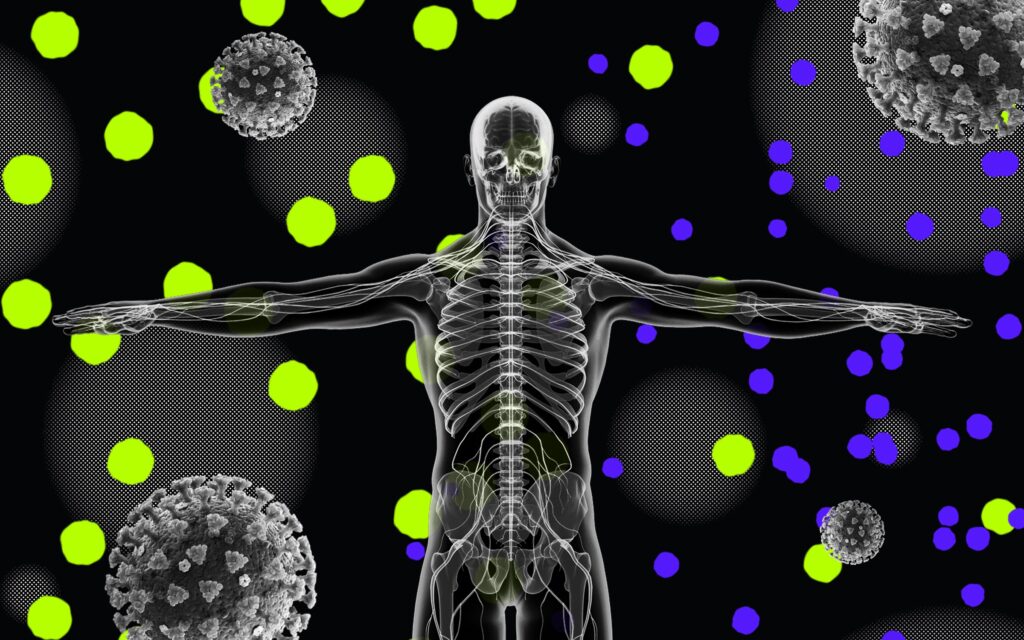- The research from the University of Southern California was able to determine that COVID-19 symptoms often start in a certain order.
- According to the study, while influenza typically begins with a cough, the first symptom of COVID-19 is fever.
- However, physicians working with patients with COVID-19 said in their experience the symptoms aren’t as predictable.
The symptoms of COVID-19, including fever and cough, are frustratingly similar to a host of other common diseases, including the seasonal flu.
With flu season around the corner, how can you tell if a fever is the flu or COVID-19? A new study has shed light on how COVID-19 symptoms present, which may help people trying to figure out if their cough is just a cough or something worse.
The research from the University of Southern California (USC) was able to determine that COVID-19 symptoms often start in a certain order.
This discovery might help people with COVID-19 self-isolate and get treatment sooner, which could significantly improve patient outcomes.
“This order is especially important to know when we have overlapping cycles of illnesses like the flu that coincide with infections of COVID-19,” said Peter Kuhn, PhD, one of the study authors and professor of medicine, biomedical engineering, and aerospace and mechanical engineering at USC. “Doctors can determine what steps to take to care for the patient, and they may prevent the patient’s condition from worsening.”
To predict the order of symptoms, researchers analyzed rates of symptom incidence collected by the World Health Organization (WHO) for over 55,000 confirmed COVID-19 cases in China. They also looked at a data set of almost 1,100 cases collected between December and January by the China Medical Treatment Expert Group for COVID-19 and provided by the National Health Commission of China.
To compare the order of COVID-19 symptoms to influenza, the researchers analyzed data from over 2,000 COVID-19 cases in North America, Europe, and the Southern Hemisphere reported to health authorities between 1994 and 1998.
“The order of the symptoms matter,” said Joseph Larsen, lead study author and USC Dornsife doctoral candidate. “Knowing that each illness progresses differently means that doctors can identify sooner whether someone likely has COVID-19, or another illness, which can help them make better treatment decisions.”
According to study findings, this is the order of symptoms that patients can experience:
- fever
- cough and muscle pain
- nausea or vomiting
- diarrhea
“The study found that patients with seasonal flu more commonly developed a cough before the onset of fever,” Dr. Robert Glatter, emergency physician, Lenox Hill Hospital, in New York, told Healthline. “In reality, this may be difficult to discern since the flu often begins abruptly with a triad of symptoms, including back pain, chills, along with a dry cough.”
Glatter said that the study findings are potentially useful “when evaluating multiple patients in a busy clinical setting.”
According to the study, while influenza typically begins with a cough, the first symptom of COVID-19 is fever.
“Our results support the notion that fever should be used to screen for entry into facilities as regions begin to reopen after the outbreak of Spring 2020,” the study authors wrote.
In difficult times, you need to be able to turn to experts who understand and can help strengthen your mental well-being. We’re here for you.
Glatter shared his experience treating patients with COVID-19 in New York City.
“In general, while fever is usually the most commonly described initial symptom of COVID-19 infection, the reality of what I see on the front lines is more variable,” he said. “In fact, some patients may present only with loss of taste or smell and otherwise feel well. I have also seen patients present with ‘COVID-toes,’ or chilblains; a livedo-type [reddish-blue discoloration] of skin reaction in response to acute inflammation, in the absence of fever, cough or other respiratory symptoms.”
Glatter said that other patients have also “presented with malaise, headache, and dizziness,” that in some ways resembles the symptoms of stroke, but without fever, cough, or any evidence of upper respiratory symptoms.
“I have also seen patients present only with chest pain, devoid of any respiratory symptoms,” he said. “The onset of nausea, vomiting, and diarrhea after onset of respiratory symptoms such as fever and cough may also suggest that a person may have COVID-19.”
According to Glatter, the bottom line is that healthcare professionals need to be vigilant and keep an open mind when evaluating patients who may have symptoms associated with the disease. “They don’t always present ‘according to the book,’ so you must cast a wide net when thinking about who may or may not have COVID-19,” he said.
“It’s critically important to understand the progression of symptoms of COVID-19-infected persons so you stop the spread of the disease — in effect, isolate and then initiate effective contact tracing,” said Glatter. “This is quite relevant for a virus that is two to three times more transmissible than influenza, leading to outbreaks in clusters.”
He also said that understanding the first symptoms not only helps patients more rapidly seek testing, but also to begin physically or socially distancing themselves after the first symptoms begin. “It also underscores the importance of wearing masks and hand hygiene upon learning of symptoms,” Glatter said.
He also finds that sudden loss of smell and taste and inflammatory skin reactions like chilblains “may be important clinical clues that may distinguish COVID-19 from seasonal influenza.”
Source: healthline.com


